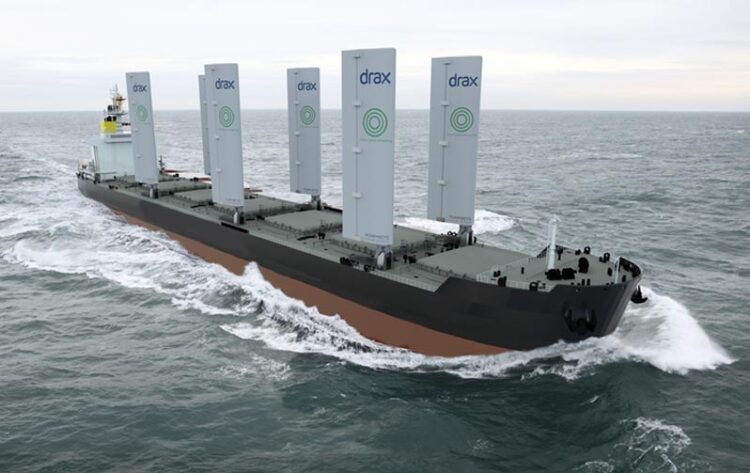Future cargo ships could be powered by wind to fight climate change

Future ships could be powered by wind to fight climate change
Photo by Smart Green Shipping
- Scientists to retrofit large shipping vessels with ultramodern sails in efforts to cut carbon emissions
- University of Southampton initiative will investigate how modern vessels perform on the ocean when fitted with the wing-sails
- Funding from Innovate UK to investigate the potential of the technology and decarbonise the UK’s maritime sector
SHIPS of the future could once again be powered by wind if a pioneering project which retrofits large vessels with ultramodern wing-sails proves successful in cutting carbon emissions.
Scientists from the University of Southampton have received funding from Innovate UK to investigate the potential of the technology as part of efforts to decarbonise the UK’s maritime sector.
The research team intends to create new software tools which accurately predicts how modern vessels perform on the ocean when fitted with the FastRig wing-sails, developed by UK company Smart Green Shipping.
Lead scientist Dr Joseph Banks, from Southampton’s Marine and Maritime Institute, said that global shipping needs to decarbonise quickly.
He added: “Ships powered by wind is obviously nothing new – but almost every large vessel operating today is powered by fossil fuels, leaving a lasting mark on the environment. While new wind-assist technologies are being developed, many are not ready for market and their predicted fuel savings have not been independently verified at sea, which is why UK-funded research projects like this are so important.”
The grants for the Winds of Change project, the collaboration between Southampton and Smart Green Shipping, was provided by the Department for Transport and Innovate UK, which is working to transform the UK into a world-leader for generating clean maritime equipment.
As part of the two-year development programme, scientists will test the impact of a retractable 20metre-high FastRig wing-sail retrofitted on commercial ship the Pacific Grebe – a British 105 metre vessel.
Dr Banks added: “This is an innovative project because the technology can be retrofitted to pre-existing vessels to quickly reduce emissions from the existing ships and help create quieter, emission-free ships in the future that do no harm to ocean environments and improve air quality in ports towns and cities.
“Our team of researchers will investigate the complex interactions between the wing-sails and the ship hydrodynamics enabling accurate predictions of vessel performance which will be compared to the demonstration vessel Pacific Grebe as part of the project.”
Experts from Southampton’s Marine and Maritime Institute hope their new tool, which predicts the fuel savings delivered by the wing-sails, will drive further investment in the UK’s marine technology sector and encourage the next generation into the exciting field of Maritime Engineering
Smart Green Shipping CEO Diane Gilpin said: “I’m thrilled that the UK is demonstrating ongoing faith in our FastRig technology, which holds the key to rapidly reducing emissions from shipping. Climate science is clear that shipping must rapidly reduce emissions in the short term. Wind power harnessed using sophisticated digital software and well-engineered equipment is at present the fastest way for the sector to reduce fuel consumption and related emissions.”
Read more about the world-leading technologies and research being developing by the University of Southampton Marine and Maritime Institute at www.southampton.ac.uk/smmi.
Media Contact
James Haigh
University of Southampton
j.haigh@soton.ac.uk
Office: 23805 99192
All latest news from the category: Power and Electrical Engineering
This topic covers issues related to energy generation, conversion, transportation and consumption and how the industry is addressing the challenge of energy efficiency in general.
innovations-report provides in-depth and informative reports and articles on subjects ranging from wind energy, fuel cell technology, solar energy, geothermal energy, petroleum, gas, nuclear engineering, alternative energy and energy efficiency to fusion, hydrogen and superconductor technologies.
Newest articles

First-of-its-kind study uses remote sensing to monitor plastic debris in rivers and lakes
Remote sensing creates a cost-effective solution to monitoring plastic pollution. A first-of-its-kind study from researchers at the University of Minnesota Twin Cities shows how remote sensing can help monitor and…

Laser-based artificial neuron mimics nerve cell functions at lightning speed
With a processing speed a billion times faster than nature, chip-based laser neuron could help advance AI tasks such as pattern recognition and sequence prediction. Researchers have developed a laser-based…

Optimising the processing of plastic waste
Just one look in the yellow bin reveals a colourful jumble of different types of plastic. However, the purer and more uniform plastic waste is, the easier it is to…



